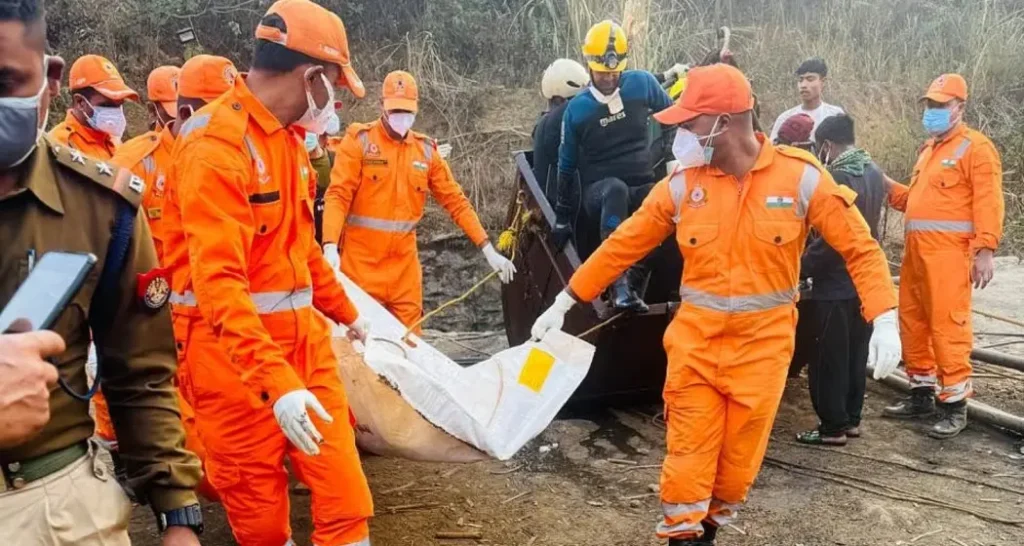Guwahati, March 11, 2025 — In a tragic culmination of a harrowing 44-day search operation, the bodies of five miners trapped in a flooded illegal coal mine in Assam have been recovered, raising serious concerns over unregulated mining practices in the state. The disaster, which occurred on January 6, 2025, initially trapped nine miners, of whom four bodies were recovered earlier, while the remaining five were found on February 19, authorities confirmed.
Details of the Tragedy
The incident took place in Patgaon village of Assam’s Tinsukia district, an area known for its illegal “rat-hole” coal mining—a dangerous method of mining involving narrow, horizontal tunnels. The mine was reportedly flooded suddenly due to the collapse of a nearby embankment, trapping all workers inside with no way to escape. Despite rescue efforts hampered by adverse conditions, state emergency services, the National Disaster Response Force (NDRF), and local volunteers continued their search until the last bodies were recovered.
The Victims and Their Families
All nine miners belonged to poor, working-class families, primarily dependent on daily wages earned through mining activities. The delayed recovery of their bodies has left their families devastated and raised questions about the lack of safety protocols and regulatory oversight in Assam’s coal mining sector.
Speaking to the media, family members of the deceased expressed anger and grief, criticizing both the mine operators for negligence and local authorities for failing to regulate illegal mining. Compensation and rehabilitation for affected families are now under discussion, but no official announcement has been made.
Illegal Rat-Hole Mining: A Persistent Danger
This tragedy has reignited debate over “rat-hole” mining, a method banned in several Indian states, including Meghalaya, due to its hazardous working conditions. However, a lack of enforcement and rampant corruption have allowed such operations to flourish in Assam, endangering countless workers.
Rat-hole mining is particularly dangerous because:
- Narrow tunnels collapse easily.
- Flooding risks are high due to unscientific excavation methods.
- Lack of ventilation and oxygen, leading to asphyxiation risks.
- Zero compliance with mining safety standards, leaving miners vulnerable.
Environmental activists and labor rights organizations are calling for urgent crackdowns on illegal mining, alongside compensation and insurance frameworks for miners.
Government and Police Investigation
The Assam government has ordered an inquiry into the incident, with a focus on identifying those responsible for running the illegal mine. Senior officials from the Assam Mines and Minerals Department are expected to submit a report soon. Meanwhile, police have detained several individuals, including suspected mine owners and contractors, for questioning.
A senior district official said:
“We are investigating all aspects, including why mining continued in violation of laws, and whether officials failed to act despite knowing about these illegal operations.”
Public Outcry and Call for Policy Change
The incident has led to widespread public outrage, with demands for:
- A comprehensive ban and enforcement against rat-hole mining.
- Strict action against corrupt officials enabling illegal mining.
- Financial compensation and long-term support for victims’ families.
- Rehabilitation programs for miners to shift to safer employment sectors.
Labor unions and human rights groups are urging the government to strengthen mining regulations and conduct regular safety audits to prevent future tragedies.
Conclusion: The Assam coal mine tragedy serves as a grim reminder of the dangerous conditions faced by miners in India’s unregulated sectors. It highlights an urgent need for policy reforms, stringent enforcement of mining bans, and the protection of workers’ rights and lives. The nation watches as Assam’s government faces mounting pressure to act decisively against illegal mining and deliver justice to the families of the victims.

